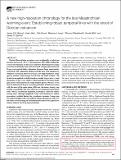Files in this item
A high‐fidelity benthic stable isotope record of Late Cretaceous–Early Eocene climate change and carbon‐cycling
Item metadata
| dc.contributor.author | Barnet, J. S. B. | |
| dc.contributor.author | Littler, Kate | |
| dc.contributor.author | Westerhold, Thomas | |
| dc.contributor.author | Kroon, Dick | |
| dc.contributor.author | Leng, Melanie J. | |
| dc.contributor.author | Bailey, Ian | |
| dc.contributor.author | Röhl, Ursula | |
| dc.contributor.author | Zachos, James C. | |
| dc.date.accessioned | 2020-10-28T10:30:01Z | |
| dc.date.available | 2020-10-28T10:30:01Z | |
| dc.date.issued | 2019-05-14 | |
| dc.identifier | 270887595 | |
| dc.identifier | f637f5f7-923e-432d-9371-9a8ccb50702f | |
| dc.identifier | 85065419284 | |
| dc.identifier.citation | Barnet , J S B , Littler , K , Westerhold , T , Kroon , D , Leng , M J , Bailey , I , Röhl , U & Zachos , J C 2019 , ' A high‐fidelity benthic stable isotope record of Late Cretaceous–Early Eocene climate change and carbon‐cycling ' , Paleoceanography and Paleoclimatology , vol. 34 , no. 4 , pp. 672-691 . https://doi.org/10.1029/2019PA003556 | en |
| dc.identifier.issn | 0883-8305 | |
| dc.identifier.other | ORCID: /0000-0003-3885-5664/work/82788868 | |
| dc.identifier.uri | https://hdl.handle.net/10023/20841 | |
| dc.description | The new Early–Middle Paleocene benthic δ13C and δ18O data were funded by the Natural Environment Research Council (NERC) Isotope Geosciences Facility at the British Geological Survey (IP‐1581–1115), awarded to James Barnet and Kate Littler. Financial support for this research was also provided by the Deutsche Forschungsgemeinschaft (DFG) to Ursula Röhl and Thomas Westerhold, and by NSF grant OCE‐1658017 to James Zachos. | en |
| dc.description.abstract | The Late Cretaceous–Early Paleogene is the most recent period in Earth history that experienced sustained global greenhouse warmth on multimillion year timescales. Yet, knowledge of ambient climate conditions and the complex interplay between various forcing mechanisms are still poorly constrained. Here we present a 14.75 million‐year‐long, high‐resolution, orbitally tuned record of paired climate change and carbon‐cycling for this enigmatic period (~67–52 Ma), which we compare to an up‐to‐date compilation of atmospheric pCO2 records. Our climate and carbon‐cycling records, which are the highest resolution stratigraphically complete records to be constructed from a single marine site in the Atlantic Ocean, feature all major transient warming events (termed “hyperthermals”) known from this time period. We identify eccentricity as the dominant pacemaker of climate and the carbon cycle throughout the Late Maastrichtian to Early Eocene, through the modulation of precession. On average, changes in the carbon cycle lagged changes in climate by ~23,000 years at the long eccentricity (405,000‐year) band, and by ~3,000–4,500 years at the short eccentricity (100,000‐year) band, suggesting that light carbon was released as a positive feedback to warming induced by orbital forcing. Our new record places all known hyperthermals of the Late Maastrichtian–Early Eocene into temporal context with regards to evolving ambient climate of the time. We constrain potential carbon cycle influences of Large Igneous Province volcanism associated with the Deccan Traps and North Atlantic Igneous Province, as well as the sensitivity of climate and the carbon‐cycle to the 2.4 million‐year‐long eccentricity cycle. | |
| dc.format.extent | 20 | |
| dc.format.extent | 272491 | |
| dc.language.iso | eng | |
| dc.relation.ispartof | Paleoceanography and Paleoclimatology | en |
| dc.subject | Paleoclimate | en |
| dc.subject | Paleoceanography | en |
| dc.subject | Orbital forcing | en |
| dc.subject | Paleocene | en |
| dc.subject | Eocene | en |
| dc.subject | Stable isotopes | en |
| dc.subject | QE Geology | en |
| dc.subject | DAS | en |
| dc.subject | SDG 13 - Climate Action | en |
| dc.subject | SDG 14 - Life Below Water | en |
| dc.subject.lcc | QE | en |
| dc.title | A high‐fidelity benthic stable isotope record of Late Cretaceous–Early Eocene climate change and carbon‐cycling | en |
| dc.type | Journal article | en |
| dc.contributor.institution | University of St Andrews. School of Earth & Environmental Sciences | en |
| dc.identifier.doi | https://doi.org/10.1029/2019PA003556 | |
| dc.description.status | Peer reviewed | en |
This item appears in the following Collection(s)
Items in the St Andrews Research Repository are protected by copyright, with all rights reserved, unless otherwise indicated.

